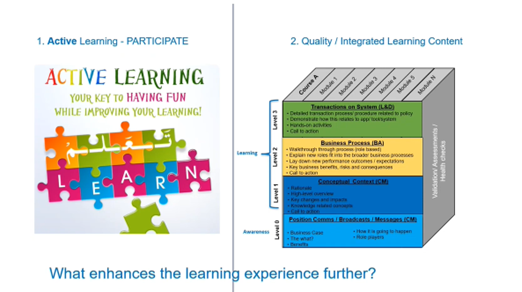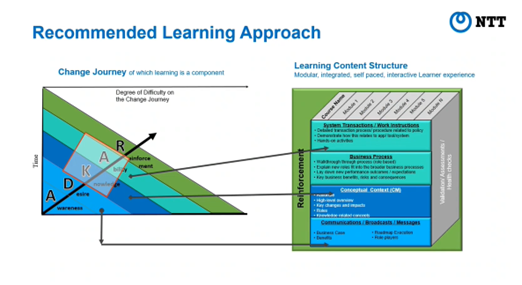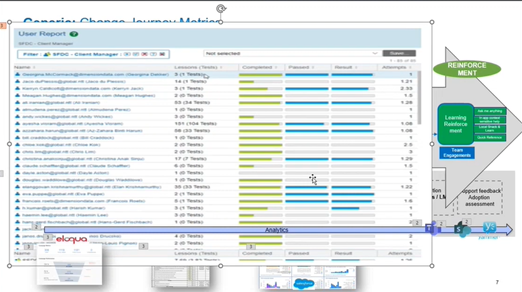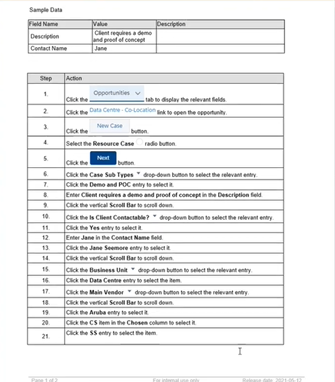A Winning Learning Formula that Drives End User Adoption with Christine Ayiotis
Executive Summary
Challenges faced by learners and facilitators in creating effective learning content, teaching data complexity, and integrating learning content in corporate training. Importance of active learning, communication, and understanding concepts in data learning. Designing a combined learning experience, applying CDMP fundamentals, and utilising tools for measuring and analysing learning metrics. Reflections on agile development and core design. Importance of readiness assessments, adoption assessment, and training success.
Webinar Details
Title: A WINNING LEARNING FORMULA THAT DRIVES END-USER ADOPTION WITH CHRISTINE AYIOTIS
Date: 11 April 2023
Presenter: Christine Ayiotis
Meetup Group: Data Governance & Data Ethics
Write-up Author: Howard Diesel
Contents
Executive Summary
Webinar Details
Challenges Faced by Learners and Facilitators in Creating Effective Learning Content
Complexity and Challenges of Teaching Data
The Importance of Active Learning for Effective Training
The Importance of Active Learning and Retention in Education
The Importance of Communication and Understanding Concepts in Data Learning
Designing an Integrated Learning Experience
Challenges in Applying CDMP Fundamentals in a Business Process
The Integration of Learning Content in Corporate Training
Importance of Data Awareness and Application on the Job
Importance of Support in the Learning Journey
Implications of AI on Learning and Professional Development
The Role of Chat GPT in Learning and Knowledge Management
The Impact and Potential Problems of Chat GPT in Knowledge Management
Importance of Data Governance and Knowledge Management
Discussion on the Importance of Change Management in Data Projects
Shift towards digital learning and limited organic engagement
Reflections on Agile Development and Core Design
Utilising Different Tools for Measuring and Analyzing Learning Metrics
Metrics and Analytics in Professional Writing
The Importance of Readiness Assessments and Effective Survey Tools
Notes on Adoption Assessment and Training Success
Challenges Faced by Learners and Facilitators in Creating Effective Learning Content
Managing time and balancing work and life while learning can be difficult for learners. They may find it frustrating to become efficient and effective with new working methods. Facilitators may struggle to allocate time for learning due to business priorities. Participants may experience anxiety and require hours to contribute effectively to the learning process. Creating learning content that is easily understood by an audience with limited prior knowledge is challenging. Facilitators may find it challenging to keep theoretical topics engaging and relevant. The DMBOK crash course, which focuses on principle-based learning, can be challenging as it requires balancing detailed knowledge with practical application. Different learning preferences (kinesthetic, auditory, visual, verbal) should be considered when creating learning material to maintain engagement.
Complexity and Challenges of Teaching Data
Data analysis can be complex. Teaching requires accommodating varying degrees of understanding and language barriers. Pre-assessments show the need to bring individuals with different levels of understanding together. Simplifying language and assuming a beginner level of knowledge helps bridge the communication gap. Discussions and questions identify those who need assistance and allow experts to learn further. Learning is a continuous process.
The Importance of Active Learning for Effective Training
Simply listening only retains up to 20% of what needs to be learned. Incorporating visual elements can increase understanding by up to 50%. Engaging in simulations or debates, active learning leads to higher retention rates. Effective communication requires active listening, which involves engaging with the speaker's words. Seeking clarification and confirming understanding during a conversation enhances active listening.
Figure 1 The importance of active learning for effective training
The Importance of Active Learning and Retention in Education
Active learning involves using both verbal and visual aids to enhance retention. Pictures provide better support for understanding and retention compared to sentences alone. Combining auditory, visual, and participative learning enhances understanding and retention. Howard's learning models use a framework and visual map to aid recall. Active participation is crucial for effective learning. The learning process should include all necessary components, not just verbal content.
The Importance of Communication and Understanding Concepts in Data Learning
The first step in data learning is communicating its value, benefits, and importance to management and learners. This creates excitement and motivation and establishes the learner's role, potential, and the value they bring. Level two focuses on understanding data concepts, including frameworks, context diagrams, and principles. This provides a framework and understanding of the complexity of data and its practical implementation.
Designing an Integrated Learning Experience
A maturity assessment and ideation session are necessary for effective data governance. The process begins with creating a data strategy and establishing an operational model. Each knowledge area or capability has its own process that must be followed. Learning involves using tools such as Power BI or Excel. In some organisations, training for processes, transactions, and knowledge bits is taught separately, which hinders integration. The ideal approach is to integrate the top three layers of learning content: concepts, processes, and transactions. Measuring the success of the integrated learning experience is a challenge, but it is essential to consider in designing content.
Figure 2 Designing an Integrated Learning Experience. What enhances the learning experience further?
Challenges in Applying CDMP Fundamentals in a Business Process
The DMBOK training prepares individuals for the CDMP exam by connecting conceptual context with actual business processes and transactions. The course consists of 16 modules, each with a specific topic, and includes post-assessments and quizzes. Veronica conducts Friday sessions to reinforce and coach learners in applying the knowledge and tools learned in a natural corporate setting. Limited training time is better spent focusing on one module at a time for better practical application.
The Integration of Learning Content in Corporate Training
Christine touches on using the SAP Enable Now authoring development tool to generate learning content for the transactional space. This tool enables the user to create reports on learners' successful completion of tests and business processes. She introduces the ADKAR model, emphasising active learning and content integration. However, implementing this integration can be challenging. A critical element in enhancing knowledge is perceiving it as a journey, and the ADKAR model helps raise awareness and desire for learning among employees. The pre-activity and pre-positioning of the learning experience significantly impact learners' motivation and engagement in the course. The business context and how managers communicate the importance of the training to their employees influence the awareness and desire stages of the ADKAR model.
Figure 3 The journey (pre and post learning)
Importance of Data Awareness and Application on the Job
Data literacy requires comprehensive training with support to bridge knowledge and application gaps. Proper support and reinforcement in the work environment are critical for successful learning. The real learning happens through applying knowledge on the job and optimising the tools used. Data awareness enhances engagement and understanding and should precede data literacy. Executives must prioritise data awareness to implement effective data literacy programs.
Importance of Support in the Learning Journey
The lack of support for learners in their journey can be improved with consistent communication from leaders, the group, or the project team. Classroom training focuses on knowledge and ability, but sustainability requires application on the job. The process is iterative, allowing for improvement, increased knowledge from colleagues, and organisational maturity. Relationships between the change journey, learning, training, and reinforcement are important. A lack of organizational support can devalue the importance of learning. Multitasking during meetings negatively affects active listening.
Figure 4 The journey (pre and post learning) continued
Figure 5 Recommended Learning Approach
Implications of AI on Learning and Professional Development
Christine stresses the importance of giving full attention to learning rather than treating it as a mechanical task. Ross raises a question about the role of AI in providing knowledge and guidance on demand. Christine agrees with the potential of AI, however, she expresses concern about the drawbacks of relying solely on AI and highlights the limitations of popular search results and the potential decrease in intellectual processes. She acknowledges the shift towards relying more on AI tools but questions where this leaves specialists and traditional learning methods.
The Role of Chat GPT in Learning and Knowledge Management
Howard discusses the formula for effective learning: 50% on the job, 33% through review with others, and 17% face-to-face learning Chat GPT enables microlearning for just-in-time knowledge acquisition. Macro learning and face-to-face engagement help learn new concepts. Christine emphasises the importance of collaboration and continuous learning in the agile world.
The Impact and Potential Problems of Chat GPT in Knowledge Management
When utilising chat GPT for knowledge management, it is crucial to approach it carefully and clearly understand its limitations. While it can be a useful tool, it has potential drawbacks, and users should be aware of these to use it effectively and safely. By being mindful of these factors, individuals and organisations can make the most of this technology while avoiding potential pitfalls.
Importance of Data Governance and Knowledge Management
The SMART acronym (Standard, Measurable, Attainable, Relevant, Time-bound) meets data management standards. Data should follow a standard, like DAMA DMBOK, and policies, procedures, and tools should be established for consistency and best practices. Utilising tools like Chat GPT can help access relevant knowledge within the organisation. Correctly setting up data governance upfront leads to leveraging benefits and facilitating quicker progress.
Discussion on the Importance of Change Management in Data Projects
Christine stresses the importance of using technology to improve learning and teaching methods for data projects. Change management specialists need to create and align a framework with program objectives. She recognises a gap in understanding change management and suggests course models to address it. The context of data projects and the need for transformational change over transactional change is emphasised. Christine mentions the collaborative effort and time spent understanding and selling the vision. Collaboration between the speaker and Christine is suggested to address the change management gap in the program. The learning process in data projects is highlighted as a social experience.
Shift towards digital learning and limited organic engagement
The shift towards digital learning is limiting engagement and collaboration. Organisations are breaking initiatives into smaller MVPs, resulting in a misunderstanding of agile principles. Christine suggests that due to the digital agile journey's brainwashing effect, the change manager struggles to understand data management from a project context. Hybrid approaches are creating a mishmash of processes and a dynamic environment.
Reflections on Agile Development and Core Design
Ross shares their understanding of agile development, which predates the mainstream use of the term. He learned about agile while transitioning to object-oriented techniques in software development. Ross emphasises the importance of core design and meeting minimum viable product (MVP) requirements in agile development. A good job on these aspects eliminates worrying about other details. He notes that the object-oriented paradigm helped them realise the extensibility of systems but also emphasised the importance of focusing on core elements. The speaker mentions the challenges individuals accustomed to waterfall thinking face in adapting to agile concepts. Christine believes that change managers should play a more significant role in the elegant space, emphasising the need for understanding the core and critical aspects before building iteratively. She acknowledges having certifications in safe Agile and expresses enthusiasm for the agile approach.
Utilising Different Tools for Measuring and Analysing Learning Metrics
Learning occurs through ability and can be measured using authoring tools. Organisations can track message opens and interactions with campaign tools. Teams can evaluate engagement and knowledge interaction through analytics within technical tools such as Teams Channels. SharePoint provides valuable insights and information. Microsoft Delve provides valuable information and insights for learners and users. Creating social channels and communities of practice can enhance knowledge sharing and intelligence gathering. Understanding the organisation's environment and tools can help effectively measure campaign metrics. Eloqua offers matrix tools for analysing learning metrics.
Figure 6 Utilising Different Tools for Measuring and Analysing Learning Metrics
Metrics and Analytics in Professional Writing
One campaign was sent to 306 recipients, with some individuals opening multiple links. The campaign contained 20 unique links and received 250 unique clicks. The click-through rate indicates communication success. Communication strategies should be adjusted based on this rate. Communication is an ongoing process requiring continuous planning and development. Systems such as Power BI and Salesforce have built-in analytics. Salesforce enables case management and post-go-live metrics tracking. Learner reports provide insights on test performance and learning engagement. Various metrics and tools should be considered, including standard metrics, authoring tools, and platform analytics.
Figure 7 Examples of metrics and analytics
Figure 8 Examples of metrics and analytics continued
The Importance of Readiness Assessments and Effective Survey Tools
Christine explains that their organisation does not have time for surveys, but she uses Microsoft Forms for post-training and adoption assessments. Readiness assessments are conducted after training and before go-live, with a suggested follow-up assessment a month after go-live to gauge tool adoption. The assessments are customised and include four areas: learning experience and project specifics. Christine emphasises the importance of user adoption readiness and mentions a "go/no-go" situation to establish readiness. Microsoft Forms is praised as an easy and powerful tool for conducting assessments. She highlights the framework's relevance to projects and emphasises the need for organisations to prioritise survey time.
Notes on Adoption Assessment and Training Success
Efficient use of adoption tool: challenges accessing information, reinforcement tool (reference guide, work instruction booklet), user-friendly interface with screenshots, quick reference card and system lessons for troubleshooting, communication impact readiness, the importance of measuring metrics, awareness and training before knowledge sharing, positive training experience, the importance of valuing participants and closing session with a request for questions.
Figure 9 Notes on Adoption Assessment and Training Success
If you want to receive the recording, kindly contact Debbie (social@modelwaresystems.com)
Don’t forget to join our exciting LinkedIn and Meetup data communities not to miss out!










